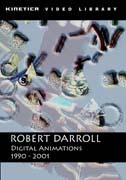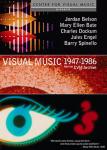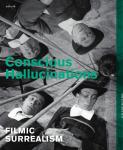The first words that come to mind about Robert Darroll’s films are density and complexity -- of imagery, technique and style. He assimilates, transforms and transcends almost every technique in the history of animation. This is the apotheosis of motion gr
| DVD Contains: | |
| Memb (1990-1993) 9 minutes
"The compositional form of MEMB refers to a subjective mental process in which form-entities act as mental events, penetrating the imaginary plane dividing self from non-self. This is an archetypal process in which the interplay of mental events within their field of activity provides the momentum for a cyclical development. The dissolution of this plane is merely a natural part of the cycle, which could be endlessly repeated, in countless variations. KIYOSHI FURUKAWA produced the sound track at the ZKM, Karlsruhe." |
 |
| Moé's Field (1993-1996) 10 minutes
"Several entries in a diary form four sections of this composition. The sections encompass very diverse pictorial elements but the semiotic connections of these elements is not predetermined for the viewer who will find whatever "meaning" is pertinent to him at that time. The four parts are based on various techniques of collage and the juxtapositioning of visual elements in long intertwining lines of change that often attain such a high degree of complexity that only single lines can be followed in each viewing. The film is intended for repeated viewing and intuitive reinterpretation despite the fact that during its production I was guided by a very specific content. KIYOSHI FURUKAWA produced the sound track at the ZKM, Karlsruhe." |
 |
| Stele (1996-1999) 11 minutes
"Does an increase in complexity imply a qualitative evolutionary advance and are we able to impose a sense of direction, or indeed a goal, on that process? Are these impositions not in fact the servants of our innate need for purpose related value? Is an illusory orientation more effective than disillusioned disorientation? Or insane contentment better than morbid insight? From this distant perspective, all that can be witnessed is an apparently aimless and fragmented ebb and flow, leaving myriads of spent forms adrift in the virtual afterworld of memory. CYNET art prize for computer animation, 2000. Kiyoshi Furukawa produced the sound track at the ZKM, Karlsruhe." Cynet art prize for computer animation, 2000
|
 |
| Noemata No. 1 (1999-2000) 6 minutes
"This composition uses documentary material interlaced in various rhythms. The individual frames of the original material have been reworked and then placed so that their numerical order is retained although they are separated by other sequences of frames. The object of this is to create a new sequence of images by blending different sequences together and by decreasing the continuity of the frames. The video also includes passages of continuous animation." Media Prize awarded by the Bund Deutsche Industrie, 2001 Asolo Art Film Festival prize for computer animation, 2002 Hoeren und Sehen Production Grant awarded by the ZKM in Karlsruhe, Germany, 2004
|
 |
| Noemata No. 2 (200-2001) 8 minutes
"Noemata No. 2 was completed after one year back in Asia. In the West, the most banal of artefacts of contemporary and traditional Asian Culture are often viewed as though, behind their sometimes obvious banality, they were concealing some profound, mysterious insight into the world, obscured from Western vision. Whereas African, Amerindian or Polynesian cultures are often observed with condescending interest, Asian Culture suggests, to the Western eye, that the enchantment of the world, the remystification of nature and existence, may be regained if one could find the key to understanding it's signs and symbols. This is it's mythology. Here we are on an island where reality is always virtual. It comes in nylon, neon, Neo-Post-modern fluorescent TV format, as mobile manga-mania of Fressundfickkultur with false eyelashes and jogging clogs. The Buddha got it right after all. Form IS emptiness. Emptiness IS form. Shigenobu Nakamura produced the sound track." |
 |
Robert Darroll (1946- ) is a British media artist living in Japan. In 1970 he recieved a DAAD Scholarship to study in Germany with Kurt Kranz, a former Bauhaus student. Darroll's first independent work, "CENIT" was completed in 1973 and in the following years he and Krantz worked on expeimental animations commissioned by ZDF (German TV). During 1983-84, Darroll lived in Song Kwang Sa in South Korea, after which he produced "The Korean Trilogy" from 1984 to 1990.
In 1990, Darroll converted his studio to digital technology and began his first computer animation entitled "Memb." This was followed by "Moé's Field," which combined cel, video and computer animation. Darroll further developed these collage techniques in "Stele." These works combine the concepts of selecting from databases, layering of sequences, and filtering selected material, with the potential of 3D CG animation. The pieces "Noemata No. 1 and No. 2" completed this phase of his work. Parallel to this, the artist was engaged to design an interactive virtual reality sequence for "Die Unbegorenen Götter," a chamber opera by Kiyoshi Furukawa, which premiered at the opening of the new Centre for Art and Media Technology (ZKM).
Darroll's current work utilizes animation in synchronized projections for larger installations. Since 2001, he has lived in Japan where he teaches Media Art at the Nagoya University of Art and Science.
The first words that come to mind about Robert Darroll’s films are density and complexity -- of imagery, technique and style. He assimilates, transforms and transcends almost every technique in the history of animation. This is the apotheosis of motion graphics – simultaneously photographic, videographic and computer graphic. Darroll creates a hypnotic and visionary universe through virtuosic use of rotoscoping, compositing, layering, filtering and complex segmentations of the frame.
Darroll understands that digital technology’s most important contribution to moving image art is the seamless merging of photographic and synthetic imagery, live action with animation. Organic figures are set against elegant geometric constructions, shot through with startling vectors and trajectories.
Visual density is matched by sonic density. Darroll’s sound design evolves from the Theremin-like electronic score of Memb to dazzling multilayered blends of natural and synthetic sounds in later works.
The earlier works show the influence of Oskar Fischinger, Viking Eggeling, Len Lye, Paul Glabicki, even a touch of Jordan Belson. But gradually he transcends them to give us the unique vision of a true master of his art. The films are ravishingly beautiful journeys through the corridors of an inspired imagination.
-Gene Youngblood











Add new comment